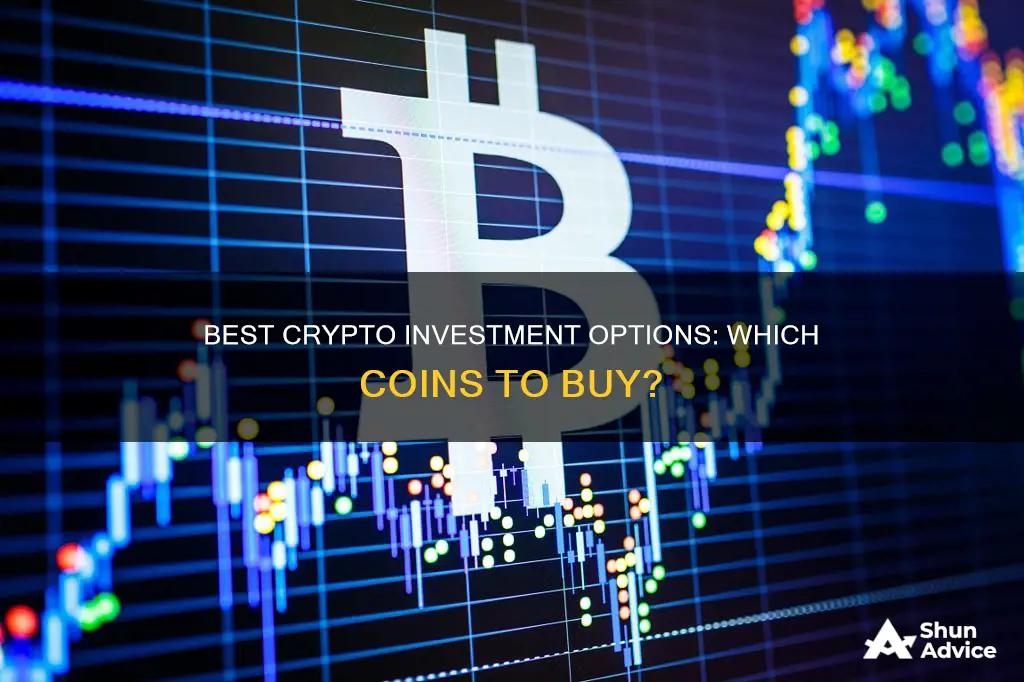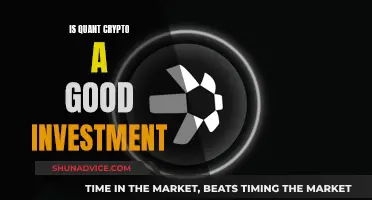
With the crypto market booming, it can be tempting to jump on the bandwagon and invest in cryptocurrencies. However, it's important to remember that crypto is a highly speculative and volatile asset class, and there are several risks associated with investing in it.
When considering which crypto coin to invest in, it's crucial to evaluate the coin's market capitalization, trading volume, liquidity, use cases, tokenomics, development team, community engagement, security, and transparency. Additionally, it's essential to understand the regulatory environment surrounding cryptocurrencies, as it varies across different jurisdictions.
While Bitcoin remains the most popular and largest cryptocurrency by market capitalization, there are several other coins that have gained traction, such as Ethereum, Solana, Cardano, and Binance Coin. These coins offer various features, including high transaction speeds, low costs, and support for decentralized applications and smart contracts.
Before investing in any cryptocurrency, it's important to conduct thorough research, understand the risks involved, and consult with a financial advisor to ensure it aligns with your investment goals and risk tolerance.
What You'll Learn

Bitcoin's fixed supply cap of 21 million coins
The idea behind the hard cap is to create scarcity and prevent inflation. As a result, Bitcoin is often referred to as "digital gold", as there is only a certain amount of it in existence. This scarcity is a significant driver of Bitcoin's value and makes it a successful store of value.
The hard cap is reached through a process called "halving", where the reward for mining new blocks is cut in half approximately every four years, gradually reducing the rate at which new Bitcoins are created until the limit is reached. It is estimated that the last Bitcoin will be mined around 2140.
The divisibility of Bitcoin also ensures that, despite a seemingly low supply, it can still serve as a medium of exchange. Each Bitcoin can be divided into 100 million units called "satoshis", allowing for flexibility in payments and accommodating a wide range of values. This high level of divisibility ensures that Bitcoin remains practical for everyday use and maintains its utility across various economic scales.
While the hard cap can theoretically be changed, it is highly unlikely to occur. The incentive and governance models in the Bitcoin protocol protect the hard cap, and any change would require widespread consensus among the nodes in the decentralised network. Additionally, removing the strict limit on the number of Bitcoins would destroy the value of the system and alienate investors and long-time believers.
Acorns and Bitcoin: Invest in Crypto via the App?
You may want to see also

Ethereum's multi-step roadmap to address network congestion
Ethereum is a blockchain platform that enables the creation and running of decentralised applications (dApps) and smart contracts. It is the second-largest cryptocurrency by market capitalisation after Bitcoin.
In recent years, Ethereum has undergone a multi-step roadmap to address network congestion and improve scalability.
The Beacon Chain and The Merge
Ethereum 2.0 began with the launch of the Beacon Chain, which introduced a parallel blockchain that operates on a proof-of-stake consensus mechanism. This marked the beginning of Phase 0 in the Ethereum 2.0 roadmap.
The Beacon Chain served as the core of Ethereum 2.0, replacing traditional miners with validators responsible for block validation. In preparation for the next phase, validators staked 32 ether (ETH) on the Beacon Chain to participate in the block validation process.
Phase 1.5: The Merge
The second phase, Phase 1.5, saw the Beacon Chain merge with the Mainnet, the traditional Ethereum blockchain. This marked a significant milestone in Ethereum's transition from a proof-of-work (PoW) to a proof-of-stake (PoS) consensus mechanism.
The Merge eliminated the need for energy-intensive crypto mining, resulting in a substantial reduction in Ethereum's energy consumption. It also introduced "validators", who are chosen randomly to approve transactions and add blocks to the blockchain while earning modest rewards.
Shanghai and Capella Upgrades
Following The Merge, Ethereum announced the Shanghai and Capella upgrades, referred to collectively as "Shapella". These upgrades represent crucial hard forks in the Ethereum blockchain, focusing on the execution layer and consensus layer, respectively.
The Shanghai upgrade aims to improve scalability, enhance support for smart contracts and decentralised applications, and reduce energy consumption. The Capella upgrade introduces notable enhancements to the consensus layer, including full and partial withdrawals for validators and an independent state that blocks historical accumulators.
The Surge, The Verge, The Purge, and The Splurge
The Ethereum roadmap includes four major upgrades with intriguing names: The Surge, The Verge, The Purge, and The Splurge. Each introduces significant advancements to address network congestion and improve scalability.
The Surge upgrade, known as Proto-dank sharding, focuses on enhancing transaction output and improving scalability through sharding. This will make it easier for the blockchain platform to support Layer 2 networks.
The Verge upgrade introduces "stateless validation", allowing validators to participate without hardware restrictions. It also reduces the amount of data needed to store the Ethereum blockchain through the use of Verkle Trees, a highly technical concept.
The Purge upgrade aims to simplify the Ethereum protocol and eliminate technical debt by purging old state data. While the data will still be available, validators will not need to interact with it.
The Splurge is a collection of miscellaneous improvements that don't fit into the other categories.
Future Plans
Beyond these upgrades, Ethereum has several other initiatives in the works. These include the use of zero-knowledge proofs for security and privacy, as well as the potential need to adapt to quantum-resistant encryption to maintain long-term security.
The Ethereum roadmap provides a clear vision for the network's evolution and planned upgrades, allowing developers to align their projects with the future direction of Ethereum and take advantage of new features.
Are Bitcoin Fees Tax Deductible as Investment Costs?
You may want to see also

Solana's high-speed and high-volume transactions
Solana (SOL) is a blockchain platform that facilitates decentralized app (dApp) development and supports crypto-currency transactions. It was launched in March 2020 by the Solana Foundation, based in Geneva, Switzerland.
What sets Solana apart is its hybrid protocol system and unique timestamp technology, which is centred around a mechanism called Proof-of-History (PoH). This system creates a verifiable and secure timestamp for each transaction, allowing nodes to process transactions without needing to communicate with one another, significantly speeding up transaction processing time.
Solana's hybrid protocol allows for significantly decreased validation times for both transaction and smart contract execution. This has attracted a lot of interest, particularly from institutional entities. Its protocol is designed to serve both small-time users and enterprise customers, aiming to make decentralized finance accessible on a larger scale.
Solana's cryptocurrency, SOL, is available to buy and sell via exchanges like Coinbase. As of September 2024, the price of Solana (SOL) is $125.98, with a 24-hour trading volume of $3.09 billion. Over the last 24 hours, the price has decreased by -6.41%.
Solana's distinctive scaling approach makes it attractive for those seeking efficient blockchain solutions. Its focus on high-speed and low-cost operations allows it to process thousands of transactions per second at a fraction of the cost of other blockchains. Solana claims it can process around 50,000 transactions per second.
A Guide to Getting Started with Litecoin Investments
You may want to see also

Avalanche's subnets for dedicated blockchains
When considering investing in cryptocurrency, it is important to do your research and understand the market. As of August 2024, Bitcoin (BTC) continues to be the most popular and valuable cryptocurrency, with a market cap of $1.2 trillion and a price of around $62,407 per coin. Ethereum (ETH) is the second-largest cryptocurrency by market cap and is a favourite of program developers due to its potential applications, such as smart contracts and non-fungible tokens (NFTs).
Now, onto the topic of Avalanches subnets for dedicated blockchains. Avalanche is a Layer 1 protocol that supports a multi-chain architecture, allowing multiple blockchains to operate simultaneously. A subnet is a sovereign network that can define its own rules for membership and tokenomics, and Avalanche validators work together to reach consensus on the state of the blockchains. Avalanche's subnets can be used by financial institutions to develop their own blockchain strategies, with customisation services and the ability to communicate with other subnets through Avalanche Warp Messaging (AWM).
Avalanche subnets have several benefits, including scalability, customisability, and security. They can scale independently of the primary network, allowing for faster transaction processing. Subnets can also be customised to meet specific needs, such as using their own gas token and virtual machine (VM). Additionally, subnets can be isolated from each other, improving the overall security of the blockchain.
The independence of subnets is another key advantage. They prevent centralisation by having their own set of validators, avoiding competition for block space. This independence allows subnets to operate without interference and enables developers to create modular applications.
Overall, Avalanche's subnets for dedicated blockchains offer a range of features that make them attractive for financial institutions and developers looking to create complex ecosystems of interconnected blockchains.
Kickstart Your Bitcoin Investment Club
You may want to see also

Chainlink's demand tied to usage of its services
Chainlink is a decentralized oracle network or blockchain abstraction layer that communicates off-chain data to a blockchain. Its oracles enable computations on and off-chain, supporting hybrid smart contracts and its cross-chain interoperability protocol. Chainlink is hosted on the Ethereum platform, which uses the proof-of-stake operating protocol. It is also an open-source blockchain project, meaning anyone can view and contribute to the code.
Chainlink's oracle services are an essential part of enabling the tokenization of assets on blockchains. Its services are the decentralized on-chain equivalent of Amazon Web Services (AWS). Invenium, for example, uses Chainlink's technology to provide real-time tracking of digital assets on blockchain networks. The demand for such services will boost the need for oracle services, and Chainlink is one of the top crypto projects in this niche, especially as asset tokenization becomes mainstream.
Chainlink's growth is directly tied to the level of demand for its oracle services since its LINK token is used to pay for access to oracle data. Expanding demand for tokenization of real-world assets should contribute to Chainlink's organic growth, resulting in positive price performance in the mid to long term.
Chainlink's oracle services are in some ways similar to the services of DocuSign (DOCU). DocuSign's founder, Tom Gonser, has been an advisor to Chainlink since 2018 and aims to integrate Chainlink smart contracts with agreements built into DocuSign documents. Bundling with a service like DocuSign could vastly extend Chainlink's capabilities, allowing them to reach well beyond blockchain applications.
The Bitcoin Gamble: Fools Rush In
You may want to see also
Frequently asked questions
Financial planner Malcolm Ethridge recommends capping your crypto allocation at 5% of your portfolio. This allows you to reap the benefits if the asset class performs well, while reducing the chances of being wiped out if it goes to zero.
The best crypto to buy depends on your circumstances and goals. If you’re using extra money to speculate, you may look for small, high-volatility altcoins. If you’re investing for diversification, you may prefer mature coins like Bitcoin and Ethereum, which have longer track records, larger market caps and more adoption by major financial institutions.
Cryptocurrencies promise cheaper and faster money transfers, and a decentralized system that does not collapse at a single point of failure. They also offer high returns and can be used to generate interest or staking rewards.
The disadvantages of crypto include price volatility, high energy consumption for mining, use in criminal activities, regulatory uncertainty, counterparty risk, management risk, programming risk and market manipulation.







